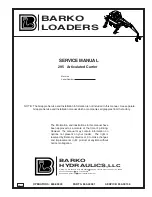
Wiard
Model GR-371 Woggle Bug
© 1996-2003 Wiard Synthesizer Company – design by Bill Sequeira/Axon Hillock
Source of Uncertainty
Woggle Bug Module Description
The newest module in the Wiard system is the Woggle Bug.
The Woggle Bug is an utterly unique module that produces
complex random voltages and tones. It reproduces the set of
random voltages available from the original Buchla Model 265
"Source of Uncertainty" module. This long out of production
module is representative of the most musical random voltage
generators produced in the first "Golden Age" of modular
synthesizers. The design has been enhanced with the
addition of 4 audio rate oscillators and 4 XOR gates which
produce the effect of ring modulation or “klang” tones.
The Woggle Bug adds 4 permanently coupled audio VCOs to
the random voltage outputs. Through a design trick, the
single mechanical module contains the equivalent
functionality of 18 electrical modules. Obviously, all the patch
points cannot be brought out to the front panel.
From a philosophical perspective, the Woggle Bug was
designed to “replace” the control voltages produced by a
keyboard during performance. Thus the Woggle Bug replaces
the output signals generated by modulation wheels, key CV,
and gate with smooth, stepped, and stepped plus LFO control
signals (respectively), generated by the module.
The modules are permanently patched into a unique
arrangement of two identical "Woggle Bugs" and their "Child
Tones". Each Woggle Bug has 3 control voltage inputs, 4
control voltage outputs and 5 audio outputs. Child tones are
the ring modulated outputs of the two Woggle Bug "parents".
The control voltage outputs are the reason for the module
and correspond to the more traditional sample and hold units
with lag processors as found in other modulars. The module
produces stepped, smoothed (lag processed) and "woggled"
(stepped voltages with decaying sinusoids at the edges)
control voltages in the range of 0 to 10 volts. These voltages
are usable with any other brand of voltage controlled
modular. The audio tones are essentially a "free" add-on due
to the design trick. The smooth voltages are produced by
cascaded lag processors which produce a "very" smooth
voltage that produces natural sounding wind and surf
patches.
The module as a whole produces 8 simultaneously available
electronic tonalities. The tonalities are deliberately very raw in
nature. Part of the 1950's sound is the simple square and
sawtooth waveforms output by electronic test equipment.
Mixed together and put through a tape delay, well, you'll be
doing battle with your Id monster in no time! Certain sets of
tones are reminiscent of the “cybernetic circuitry” used to
produce the electronic tonalities for the movie “Forbidden
Planet”. The module is produced with fine “Cold War” silicon
which is thematically consistent with a tribute to 50s and 60s
electronic music.
This applies to only some settings of the 10 controls and
some of the 8 outputs. Other settings produce the sound of
very large insects, or swarms of large insects. It can not
make keyboard sounds and can not be controlled by a
keyboard. Hooray!
Each Woggle Bug purchaser gets a free lifetime membership
in "The Loyal Order of the Woggle Bug", an imaginary
fraternal order with the privilege of displaying this fine
emblem upon your Fez.
There are two circuits in the module, see block diagram
below.
The
Woggle Bug module contains:
•
2 Voltage Controlled Low Frequency Oscillators
•
4 Sample and Hold Units
•
4 Lag Processors
•
4 Audio Rate Voltage Controlled Oscillators
•
4 Balanced Modulators ("ring modulators")
Or the contents of a somewhat large modular, in a single
module size, for the price of a single module!
The Woggle Bug is useful both as an alien sound source and
as a source of random voltages for aleatoric composition and
to add automatic articulation to static sequencer and
keyboard patches. The STEP CV out is most musical when
quantized with a Mini-Wave in 0-10 volt range. The
CLUSTERING knob will limit step-to-step excursions inside the
5 octave quantization range of the Mini-Wave.






















